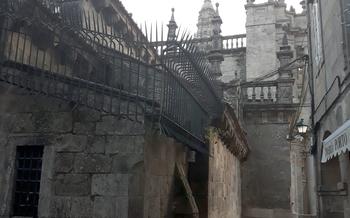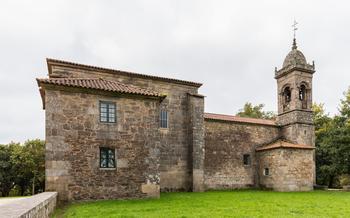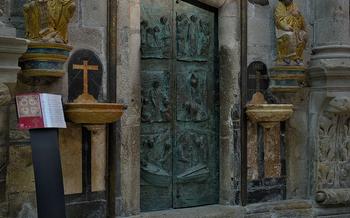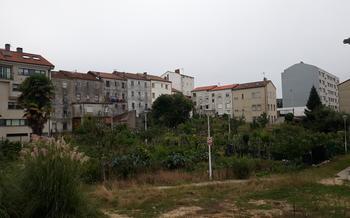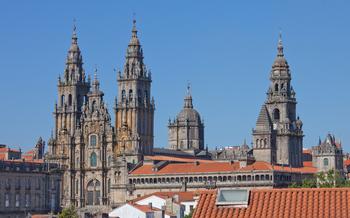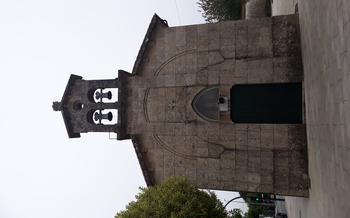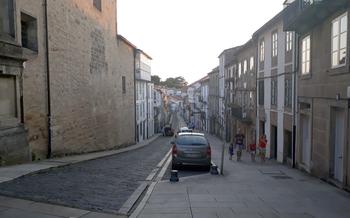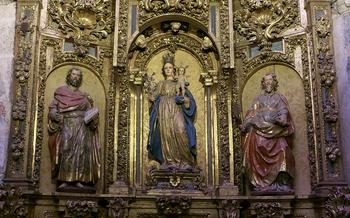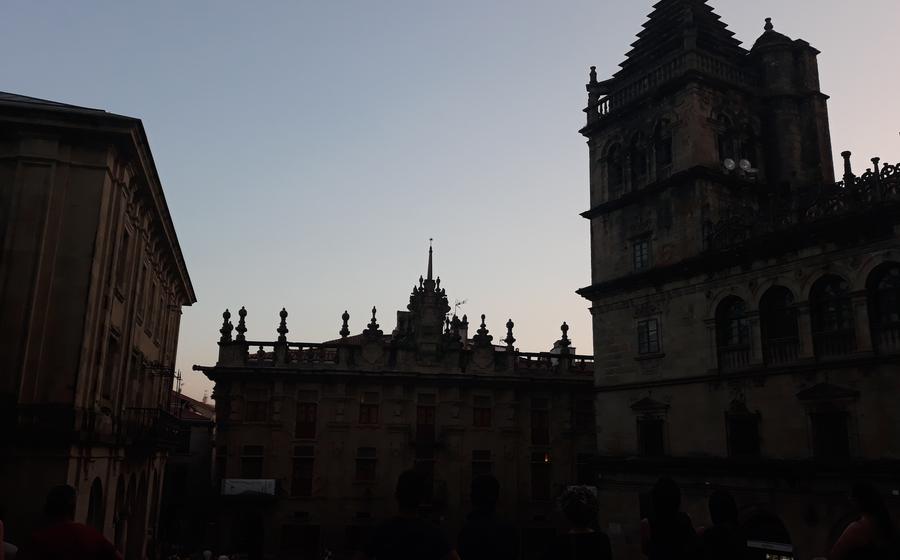
Colexiata de Sar Cloister Romanesque cloister in the Collegiate Church of Sar
- Location: A Journey Back in Time to Colexiata de Sar Cloister
- Step Inside the Sacred Grounds
- Unveiling the Architectural Masterpiece
- Exploring the Cloister's Galleries
- Discover the Collegiate Church of Sar
- The Camino de Santiago Connection
- Unveiling the Sarcophagi
- The Chapter House: A Place of Assembly
- The Sar River and Its Enchanting Surroundings
- The Legend of the Pilgrim and the Rooster
- The Legend of the Hidden Treasure
- The Cloister's Role in Local Celebrations
- Practical Tips for Visitors
- Local Delights: Exploring the Gastronomy
- Insider Tip: The Secret Garden
Location: A Journey Back in Time to Colexiata de Sar Cloister
Situated on the outskirts of Santiago de Compostela, the Colexiata de Sar Cloister stands as a testament to the enduring legacy of Romanesque architecture in Spain. One of the oldest cloisters in the country, it invites visitors to step back in time and immerse themselves in the rich history and spiritual significance of this sacred site. With its unique blend of Romanesque and Gothic styles, the Colexiata de Sar Cloister offers a glimpse into the architectural and artistic heritage of the region, making it a must-visit destination for anyone seeking a deeper connection to Spain's past.
Step Inside the Sacred Grounds
The Colexiata de Sar Cloister welcomes visitors with open arms, offering a serene and awe-inspiring experience. Its doors are open to all who seek solace, tranquility, and a glimpse into the rich history of Santiago de Compostela.
Opening Hours:
The cloister's opening hours vary depending on the season. During the summer months (June to September), it is typically open from 10 am to 1 pm and from 4 pm to 7 pm. In the winter months (October to May), it is usually open from 10 am to 1 pm and from 3 pm to 6 pm.
Admission Fees:
Admission to the cloister is free of charge, allowing everyone to experience its architectural splendor without any financial barriers.
Guided Tours:
For those who wish to delve deeper into the history and significance of the cloister, guided tours are available. These tours provide a wealth of information about the cloister's construction, its role in the Camino de Santiago pilgrimage, and the symbolism embedded within its architectural details.
Accessibility:
The cloister is wheelchair accessible, ensuring that all visitors can enjoy its beauty and tranquility. Ramps and elevators have been thoughtfully installed to facilitate easy access for those with mobility challenges.
Unveiling the Architectural Masterpiece
The Colexiata de Sar Cloister proudly stands as a testament to the fusion of Romanesque and Gothic architectural styles. Originally constructed in the 12th century, its Romanesque roots are evident in its sturdy structure and rounded arches. However, later additions in the 14th century introduced Gothic elements, such as pointed arches and intricate tracery, creating a harmonious blend of both architectural traditions.
As you step inside the cloister, take a moment to admire the exquisite carvings and decorative motifs that adorn every corner. The capitals of the columns, in particular, showcase intricate scenes from the Bible and the lives of saints, each one a masterpiece of medieval craftsmanship.
At the heart of the cloister lies the serene central courtyard, surrounded by graceful arches that create a sense of tranquility. This open space invites you to pause and reflect, immersing yourself in the beauty and serenity of your surroundings.
Exploring the Cloister's Galleries
The Colexiata de Sar Cloister boasts a remarkable double-story structure, inviting visitors to wander through both the lower and upper galleries. The lower gallery's rhythmic succession of arches creates a sense of harmony and balance, while the upper gallery offers captivating views of the cloister's courtyard and the surrounding landscape.
As you stroll through the galleries, take the time to admire the intricate carvings adorning the capitals that crown each column. These capitals showcase a variety of motifs, from biblical scenes to mythical creatures, each one a testament to the skill and artistry of the medieval craftsmen.
The upper gallery offers a unique perspective on the cloister's central courtyard, a serene space surrounded by graceful arches. From this vantage point, you can fully appreciate the beauty and symmetry of the cloister's design and admire the intricate details that make it a masterpiece of Romanesque and Gothic architecture.
Discover the Collegiate Church of Sar
The Colexiata de Sar Cloister is an integral part of the larger Collegiate Church of Sar. This magnificent structure boasts a captivating blend of Romanesque and Gothic architectural styles, showcasing the evolution of religious architecture in Spain. Explore the church's Romanesque facade, characterized by its intricate carvings and grand arches, which transport visitors back in time. Step inside to marvel at the Gothic interior, with its soaring vaulted ceilings, elegant stained-glass windows, and ornate altars. The Collegiate Church of Sar holds immense historical significance, having served as a pilgrimage site for centuries and contributing to the rich religious heritage of Santiago de Compostela. Guided tours are available to provide a deeper understanding of the church's history, symbolism, and architectural features, making it a must-visit destination for anyone seeking to delve into the spiritual and cultural legacy of this sacred site.
The Camino de Santiago Connection
The Colexiata de Sar Cloister holds a deep significance for pilgrims traversing the Camino de Santiago, a renowned pilgrimage route leading to the Cathedral of Santiago de Compostela. Situated along this historic path, the cloister has served as a sanctuary for weary pilgrims seeking solace and respite during their arduous journey.
Throughout the centuries, countless pilgrims have found comfort within the cloister's serene embrace. The cloister's tranquil atmosphere and sacred ambiance provided a much-needed haven for pilgrims to rest their weary bodies and find spiritual renewal. Here, they could gather their strength and seek divine guidance before continuing their pilgrimage towards Santiago de Compostela.
Listen to the echoes of history as you walk through the cloister's ancient corridors. Imagine the footsteps of countless pilgrims who have passed through these hallowed grounds, each carrying their own unique stories and aspirations. The cloister's walls seem to whisper tales of devotion, resilience, and the unwavering pursuit of faith.
To this day, the Colexiata de Sar Cloister remains a significant landmark for modern-day pilgrims. Many still choose to visit the cloister, paying homage to its historical significance and seeking inspiration for their own spiritual journeys. Whether you are a devout pilgrim or simply a curious traveler, the cloister's connection to the Camino de Santiago adds a profound layer of meaning to your visit.
Unveiling the Sarcophagi
Within the cloister's serene atmosphere, visitors can discover a collection of ancient stone sarcophagi, each adorned with intricate carvings and symbolic imagery. These elaborate tombs hold the remains of individuals who played a significant role in the history of Santiago de Compostela.
Crafted by skilled medieval stonemasons, the sarcophagi showcase a variety of artistic styles and techniques. Some feature finely carved figures and scenes depicting religious themes, while others display intricate geometric patterns and symbolic motifs. The carvings on these sarcophagi offer a glimpse into the beliefs and values of the people who once inhabited this sacred space.
By studying the symbolism and imagery on the sarcophagi, visitors can gain insights into the lives and legacies of the individuals interred within. These elaborately carved tombs serve as a reminder of the rich history and cultural heritage of the Colexiata de Sar Cloister, inviting visitors to contemplate the passage of time and the enduring legacy of those who came before.
The Chapter House: A Place of Assembly
Situated adjacent to the cloister, the Chapter House stands as a testament to the architectural prowess of the medieval era. A separate structure, it exudes a distinct character while harmoniously blending with the overall aesthetic of the Colexiata de Sar. Step inside to discover a captivating fusion of Romanesque and Gothic elements that speak volumes about the evolution of architectural styles.
Originally conceived as a meeting place for the canons of the collegiate church, the Chapter House served as a venue for discussions, decision-making, and spiritual reflection. Its walls bear witness to countless deliberations and exchanges of ideas that shaped the history of the Colexiata. Adorned with intricate carvings and an awe-inspiring ceiling, the Chapter House invites visitors to contemplate its rich symbolism and artistry.
The Chapter House is a testament to the enduring legacy of the Colexiata de Sar, a place where faith, community, and architectural excellence converged. Its unique blend of Romanesque and Gothic elements offers a glimpse into the evolution of architectural styles and the diverse influences that shaped the cultural heritage of Santiago de Compostela.
The Sar River and Its Enchanting Surroundings
Beyond the cloister's sacred grounds, the Sar River meanders gracefully, inviting visitors to explore its picturesque beauty. Take a leisurely stroll along its banks and immerse yourself in the tranquil landscapes that have captivated generations. Discover the river's historical significance, as it has played a pivotal role in shaping the story of Santiago de Compostela.
Unravel the local legends and myths that intertwine with the Sar River, adding a touch of enchantment to your visit. These tales have been passed down through generations, weaving a rich tapestry of cultural heritage. Let the river's gentle flow transport you to a realm of imagination and wonder.
The Legend of the Pilgrim and the Rooster
Amidst the cloister's hallowed grounds, a captivating legend unfolds, passed down through generations of pilgrims and locals alike. It tells the tale of a weary pilgrim who, lost and alone, found himself in the depths of the Sar River. As the river's currents threatened to sweep him away, a miraculous rooster appeared, guiding him to safety with its persistent crowing.
The legend holds profound symbolism, representing the divine intervention and protection that pilgrims sought during their arduous journeys along the Camino de Santiago. The rooster, often associated with vigilance and protection, serves as a symbol of hope and guidance for those who undertake this sacred pilgrimage.
This enchanting tale has become an integral part of the cloister's identity, woven into its very fabric. It reminds visitors of the spiritual significance of the cloister and the profound impact it has had on countless pilgrims throughout history.
The Legend of the Hidden Treasure
Legends are an integral part of any culture, adding layers of mystery, intrigue, and enchantment to a place. The Colexiata de Sar Cloister is no exception. Woven into its history is the captivating tale of a hidden treasure buried within the cloister grounds.
The legend, passed down through generations, speaks of a secret chamber hidden beneath the cloister, guarded by ancient enchantments and riddles. Within this chamber lies a treasure of immense value, waiting to be discovered by a worthy seeker.
The origins of the legend are shrouded in mystery, but it has become deeply embedded in the local folklore. Treasure hunters from far and wide have been drawn to the cloister, hoping to unravel the clues and claim the hidden riches.
Some say that the treasure was buried by a wealthy noble family during a time of war to protect their fortune from marauding invaders. Others believe it is the treasure of a legendary order of knights who once guarded the Camino de Santiago.
Regardless of its origins, the legend of the hidden treasure adds an air of excitement and mystery to the Colexiata de Sar Cloister. Visitors can embark on a symbolic treasure hunt, following clues and riddles that lead them through the cloister's grounds, unlocking its secrets and uncovering its hidden stories.
The Cloister's Role in Local Celebrations
The Colexiata de Sar Cloister is not merely a historical monument but also a vibrant part of the local community. Throughout the year, the cloister plays a significant role in various festivals, events, and celebrations that reflect the rich cultural heritage of Santiago de Compostela.
One of the highlights is the annual celebration honoring the patron saint of the church, Santa María Salomé. This joyous occasion features colorful processions that wind through the cloister's grounds, accompanied by traditional music and dancing. Locals and visitors alike come together to pay homage to their patron saint and immerse themselves in the festive atmosphere.
Another notable event is the traditional Corpus Christi procession, a religious ceremony that takes place in the streets of Santiago de Compostela. The procession passes through the cloister, where the elaborate floats and ornate tapestries create a mesmerizing spectacle. This event showcases the deep-rooted Catholic traditions of the region and attracts numerous spectators each year.
Beyond religious celebrations, the cloister also serves as a venue for cultural events and performances. Local artists, musicians, and performers showcase their talents within the cloister's historic walls, creating a unique and immersive experience for visitors. These events not only celebrate the local culture but also contribute to the vibrant artistic scene of Santiago de Compostela.
By participating in these local celebrations and events, visitors can gain a deeper understanding of the cultural and religious traditions of Santiago de Compostela and experience the city's vibrant community spirit firsthand.
Practical Tips for Visitors
To ensure a smooth and enjoyable visit to the Colexiata de Sar Cloister, consider the following practical tips:
- Dress Code:
-
Show respect for the sacred nature of the site by dressing appropriately. Conservative attire is recommended, covering shoulders and knees.
-
Photography:
-
Capture the beauty of the cloister with your camera. Photography is permitted, but be mindful of other visitors and avoid using flash.
-
Accessibility:
-
Wheelchair access and ramps are available throughout the cloister grounds, ensuring a comfortable visit for all.
-
Restrooms:
- Public restrooms are conveniently located within the cloister grounds, providing essential facilities for visitors.
Local Delights: Exploring the Gastronomy
A culinary journey awaits visitors to Santiago de Compostela, where the flavors of Galicia come alive. Indulge in traditional dishes that showcase the region's rich culinary heritage, from hearty stews like "caldo gallego" to freshly caught seafood delicacies. Explore the vibrant local markets, where vendors display an array of fresh produce, artisanal cheeses, and cured meats. Savor the flavors of regional wines, crafted from local vineyards, and experience the warmth of Galician hospitality in the charming restaurants that dot the city. Whether you prefer a casual tapas bar or a refined dining establishment, Santiago de Compostela offers a culinary adventure that will tantalize your taste buds and leave you craving for more.
Insider Tip: The Secret Garden
Beyond the cloister's hallowed halls lies a hidden gem, a secret garden that invites visitors to immerse themselves in tranquility and natural beauty. This enchanting oasis, tucked away from the bustling city streets, offers a serene escape for weary travelers and a glimpse into the cloister's rich history.
As you step into the garden, the air fills with the sweet fragrance of blooming flowers and the gentle rustling of leaves. Lush greenery surrounds you, creating a secluded haven where time seems to slow down. Wander along the winding paths, discovering hidden corners and charming vistas at every turn.
The garden's historical significance is intertwined with the cloister itself. It was once a place of contemplation and meditation for the monks who resided here, a sanctuary where they could find solace and connect with nature. Today, it continues to serve as a place of peace and reflection, inviting visitors to pause and appreciate the simple beauty of the natural world.
With its tranquil atmosphere, historical charm, and picturesque scenery, the secret garden is a must-visit for anyone seeking a moment of respite and tranquility during their exploration of Santiago de Compostela. Be sure to bring your camera to capture the beauty of this hidden gem, a lasting memory of your journey to this sacred site.
